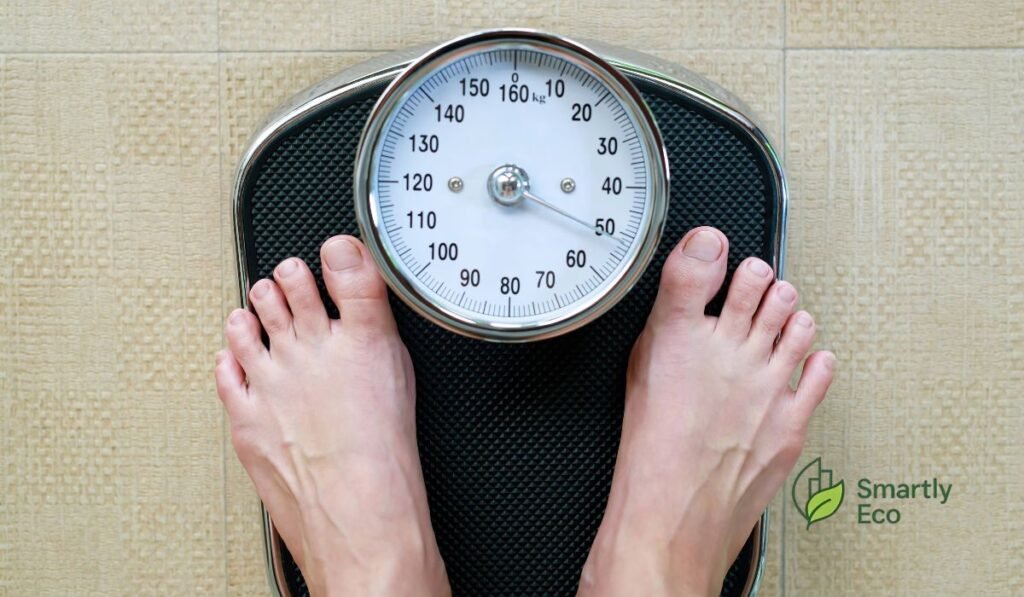Most people talk about weight loss, but gaining healthy weight is just as big a struggle—especially for young adults and college students living in cities. I’ve seen it firsthand with my younger cousin, who despite eating a lot of random food, couldn’t put on weight in a healthy way. His body always looked lean, and he kept complaining that nothing worked.
Turns out, the problem wasn’t about eating more food, but about eating the right food at the right time. So, if you’re tired of stuffing yourself with junk and still not seeing results, this routine will help. It’s based on Ayurveda, modern nutrition, and tested daily habits that are easy to follow for anyone living in an urban lifestyle.
Let’s walk through a full-day diet and lifestyle plan, from the moment you wake up till you sleep.
Morning: Starting the Day Right
1. Hydration First (7:00 AM)
The very first thing after waking up? Drink 2–3 glasses of plain or lukewarm water. Not fancy detox water, not lemon-honey trends—just clean water. This simple step kickstarts digestion, clears toxins, and makes your stomach ready for real food.
Tip: If you can, drink slightly warm water. It helps clean the system better.
2. Oil Pulling (7:15 AM)
An underrated Ayurvedic practice. My cousin used to skip it, but once he started, his digestion improved. Swish a spoon of sesame or coconut oil in your mouth for 5–7 minutes. This helps in balancing dryness in the body, which Ayurveda says is one hidden reason people fail to gain weight.
Breakfast: Fuel for Growth (8:30 AM)
Most people skip breakfast or grab something packaged. Wrong move. For weight gain, breakfast is the king.
Options:
- Milk-based porridge (daliya or oats) with nuts like soaked almonds.
- Vegetable upma roasted in ghee.
- Paneer-stuffed paratha with curd or homemade butter.
👉 The rule? Whole grains + protein + good fat (like ghee/butter).
My cousin tried rotating these options daily, and within weeks he noticed more energy and less bloating compared to packaged cereals.
Mid-Morning Snack (11:00 AM)
Instead of samosas or biscuits with tea, go for nutrient-dense snacks:
- 1–2 bananas
- Seasonal fruits (mangoes, guava, apples depending on season)
- 4–5 dates with a glass of milk
- Sprouts or boiled chana with lemon & spices
These foods are calorie-rich but natural—exactly what underweight people need.
Lunch: Balanced and Hearty (1:30 PM)
Here’s where Indian home food works best.
A good lunch plate:
- 2–3 whole wheat rotis (brushed with ghee)
- Rice + dal combo (yes, eat both)
- 1 sabzi (paneer, chole, rajma, or even jackfruit curry)
- Salad on the side
- A glass of buttermilk with roasted cumin
👉 Eating roti + rice together may sound heavy, but it’s actually an Ayurvedic recommendation for those trying to gain weight naturally.
Post-Lunch (Optional Nap) (2:30 PM)
If you’re in the habit of afternoon naps, that’s fine—but keep it short (20–30 minutes max) and always on the left side. This supports digestion and prevents sluggishness.
Evening Snack (5:00 PM)
This is the danger zone for most urban folks—where fried samosas, vada pav, or instant noodles sneak in. My cousin was guilty of this too.
Instead, better choices include:
- Roasted chana + peanuts
- Another fruit with curd
- Banana with peanut butter on whole wheat bread
- Chana chaat with chopped onions, coriander, and lemon
These small swaps stop the belly from bulging while still giving enough calories for healthy weight gain.
Workout + Recovery Snack (6:30 PM)
Yes, workouts matter even for gaining weight. Without resistance training, extra calories just become belly fat. A simple full-body routine 3–4 times a week is enough.
Post-workout, have:
- 1 glass of milk with protein (like banana or whey if you take supplements)
- Or paneer/tofu stir-fry
Dinner: Lighter but Wholesome (8:30 PM)
Dinner is similar to lunch but slightly lighter:
- 2 rotis with ghee
- A dal or light curry
- Vegetable sabzi
Avoid: curd, cucumber, or banana at night—they disturb digestion.
Add spices like black pepper and bay leaf in rice for better digestion. Also, make sure to have dinner as early as possible!
Bedtime Routine (10:30 PM)
Before sleeping, have:
1 glass of warm milk with half a spoon of ashwagandha powder (or ghee, turmeric, honey alternately).
This soothes the nervous system, aids recovery, and is highly recommended in Ayurveda for natural weight gain.
How to Build This Habit Daily?
Let’s be honest: reading a diet plan is easy, but living it daily—especially in a fast-paced city—is hard. Offices, late-night work calls, traffic, and social life often throw our plans off track. So instead of trying to change everything overnight, here’s how you can slowly build these habits without burning out:
Step 1: Start with One Strong Anchor Habit
Pick just one change for the first week. For example, never skipping breakfast. Even if the rest of the day goes haywire, your anchor habit keeps you grounded.
Step 2: Prep Food the Night Before
Urban life = unpredictable mornings. Keep soaked almonds, chopped veggies, or sprouted chana ready the night before. This way, you don’t rely on packaged food when you’re rushing.
Step 3: Use the “Carry Rule”
Always carry at least one backup snack in your bag—like bananas, dates, or roasted chana. This prevents you from grabbing fried snacks during office breaks.
Step 4: Set Timers on Your Phone
It may sound silly, but reminders actually work. Set small alarms for breakfast, mid-morning fruit, and evening snacks. Over time, your body clock adjusts naturally.
Step 5: Weekend Meal Prep
City life leaves no room for cooking every day. Dedicate Sunday evenings to cook bulk dal, rajma, paneer curries, or even chapati dough. Store in the fridge and just reheat when needed.
Step 6: Build Slowly, Not Perfectly
Don’t aim to follow 100% of the plan from Day 1. Add one habit every 3–4 days. Within a month, you’ll be living the full routine without even noticing the shift.
👉 The key is consistency, not perfection. Even if you stick to 70% of the plan daily, results will come in a few weeks.
Practical Habits for Urban Life
Sticking to this plan is easier said than done. Here are some do’s and don’ts my cousin learned the hard way:
Do’s ✅
- Carry dry fruits or fruit in your bag for office/college.
- Cook simple, repetitive meals—don’t chase fancy recipes daily.
- Drink water throughout the day (not just at meals).
- Sleep 7–8 hours. No diet works without good sleep.
Don’ts ❌
- Don’t rely on fast food, thinking “it’s calorie-dense, so it will help.” It only gives belly fat, not healthy weight.
- Don’t skip meals—consistency is the only way this plan works.
- Don’t binge on tea/coffee; they kill appetite.
FAQs
Q1. What is the healthiest way to gain weight for skinny people?
The healthiest way is to focus on whole foods—milk, ghee, nuts, lentils, paneer, and fruits—combined with resistance training. Instead of junk calories, choose nutrient-dense meals that build muscle and strength.
Q2. How can I gain weight with an Indian vegetarian diet?
Include roti + rice together with dal, paneer curries, ghee, and buttermilk in lunch and dinner. Snack on bananas, dates, dry fruits, and sprouted chana. Finish your day with warm milk and ashwagandha for recovery.
Q3. Does drinking milk at night help in weight gain?
Yes, having a glass of warm milk before bed (with ghee, turmeric, honey, or ashwagandha) supports digestion, improves sleep, and aids muscle recovery—all of which help in healthy weight gain.
Q4. Can skipping meals stop weight gain?
Absolutely. Consistency is key. Skipping breakfast or snacks makes it hard to meet calorie needs and slows down progress. Setting reminders or carrying snacks helps city dwellers stay on track.
Q5. What workouts are best for gaining weight naturally?
Strength training is crucial. Focus on simple full-body routines 3–4 times a week (push-ups, squats, resistance bands, or weights). Exercise ensures the extra calories turn into muscle, not belly fat.
Q6. How long does it take to see visible weight gain results?
With consistent eating and workouts, results are usually visible in 3–4 weeks. Within 2–3 months, most people notice fuller muscles, improved energy, and better body shape.
Q7. Can I gain weight by eating junk food like burgers and fries?
Junk food may add belly fat, but it won’t give you healthy muscle or energy. Instead, it disturbs digestion and appetite. Always prefer natural calorie-dense foods like bananas, nuts, paneer, or chana.
Results & Real Talk
When my cousin followed this for 15 days strictly, we could actually see the difference: his face looked fuller, clothes fit better, and energy levels went up. But the real magic happened in 2–3 months of consistent eating + workouts.
Weight gain is not overnight—it’s a lifestyle. And unlike junk calories, this plan builds strength, not just size.
Conclusion
Gaining weight isn’t about eating endlessly. It’s about structured eating, balanced nutrients, and discipline. For city dwellers, where life is hectic and food choices are often compromised, following a clear routine like this makes all the difference.
If you’ve struggled to put on weight despite trying everything, give this plan at least 4 weeks. You’ll be surprised how much your body can change when fed the right way.
👉 Remember: it’s not just about adding kilos, it’s about building a stronger, healthier version of yourself.
Nikita Palesha is a wellness advocate and eco-conscious writer who shares simple, sustainable tips for everyday living. She’s passionate about mindful choices that support a healthier planet and a balanced lifestyle.




